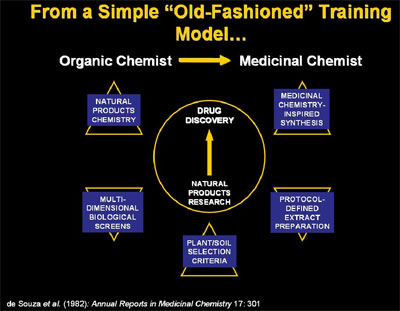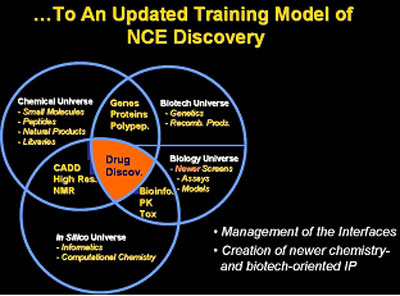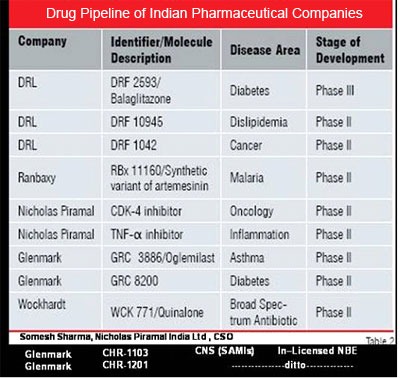|
|
 |
Medicinal Chemistry in India
Drug Discovery & Intellectual Property Scenario in India: Reorienting the Medicinal Chemistry Syllabi
A critical element that has influenced an altered status for medicinal chemists in India is the globalization phenomenon pervading emerging countries like India, pursuant to its participation in GATT and WTO agreements. As a consequence of TRIPS, India has promulgated the India Patents (Amendments) Act, 2005, which permits that product patents, and not only process patents, are grantable for foods, drugs and medicines. Pre-1995, there was merely a thimbleful number of multinational pharmaceutical companies engaged in drug discovery efforts. To find a medicinal chemist then was like looking for an “exotic needle in a haystack”. Post-1995, a few leading major Indian pharmaceutical companies did also enter the game of drug discovery. The demand for medicinal chemists began to grow. Post-2005, both multinational and major domestic pharmaceutical companies in India are experiencing a paradigm shift from business-driven research to research-driven business, with an increased R&D thrust focused not only on development of innovative/indigenous processes for known drugs but also on the discovery of new drugs. The medicinal chemist workforce engaged in innovation, now approximates five hundred in number, is forecast to double in 1-2 years. Expatriates are increasingly being attracted to return to India by the burgeoning drug discovery industry.
The training models used with the medicinal chemists also underwent a change. Figure 1 depicts a simple “old-fashioned” model to discover drugs in a natural products research programme during the 1970-1990s. Despite having to operate in a small Indian facility, isolated from the sophistication available in laboratories of the developed world, the team produced two molecules that have received international acclaim for being the first unique molecules of their class, viz. (a) Forskolin, a diterpenoid adenylate cyclase activator, a semisynthetic analog of which has been introduced in Japan by Nippon Kayaku for congestive cardiomyopathy, and (b) Flavopiridol, the first cyclin-dependent kinase inhibitor, in advanced clinical trials for prostate cancer. Figure 2 depicts the later updated model introduced (1997-2006) for NCE discovery, resulting in patentable fluoroquinolone and oxazolidinone analogs as potential anti-methicillin resistant Staphylococcus aureus agents (3). The depicted table provides information on an impressive array of recent new drugs in the pipeline of major Indian pharmaceutical companies.
Consequent towards meeting the increase in demand for a newer breed of medicinal chemists, the government, teaching bodies and research centers of domestic and multinational pharmaceutical companies are all engaged in newer approaches, characterized however by fragmentation in respect of syllabi, research programmes, standards, objectives, practices and goals. Medicinal Chemistry as a stand-alone department has begun to be introduced in a few institutes and universities, while in others continuing to remain as part of programmes of departments of pharmaceutical chemistry. The current and future prospects of medicinal chemistry education in India can be envisaged as leading into:
- Well-structured graduate teaching and doctoral programmes under one roof, for instance in centers of excellence like the National Institute of Pharmaceutical Education and Research, the Indian Institutes of Technology, the Indian Institute of Science, the Central Drug Research Institute, the University Institute of Chemical Technology, the National Chemical Laboratory, the Indian Institute of Chemical Technology, the Birla Institute of Technology and other leading Universities
- Syllabi orientation to assimilate curricula of concomitant emerging technologies in drug design, biotechnology, and newer disciplines such as chemical/systems biology, chemical genetics, chemo-bio-informatics, IPR, project management, different disciplinary methodologies and ancillary pharmacological disciplines
- Interdisciplinary teaching, and research symbiosis & coordination
- Development of internationally visible research groups and scientists, fostering a local post-doctorate culture, with some focus on indigenous research themes related to India’s traditional system of medicine, neglected diseases, and exclusive ethnic gene pools
- Balanced treatment of federally-funded institutions versus state-funded universities, with policies avoiding feudalism and elitism, whilst demanding accountability.
- The opportunities for medicinal chemists, whether budding or established or foreign-returned, have never been so favorable as they now are. India is engaged in a vaulting bid to emerge as a global world-class “knowledge-powerhouse”. Significant funding initiatives have been made by the Indian government in billion-dollar budgetary allocations for science and technology research. A group of five new premier interdisciplinary research-devoted Indian Institutes of Science Education and Research should have a strong appeal to aspiring medicinal chemists. Collaborative links between government, corporates and academia are increasing.
There is no Indian Society of Medicinal Chemistry, as exists for different other long-established Indian Societies related to chemistry-associated disciplines such as societies of Bio-Organic Chemists, Biological Chemists, Chemists and Biologists, and associations of Pharmaceutical Scientists, and Clinical Biochemists, to name a representative few. Some scientific journals publish reports of medicinal chemistry content in appropriately-classified sections. Themes related to emerging concepts and practices in medicinal chemistry are the focus of periodically held conventions, conferences and meetings hosted by societies, research institutions and companies of the pharmaceutical industry. It would be a positive benefit if through circulation of this newsletter to teachers, scientists and policy-makers in the field of Medicinal Chemistry in India, it could lead to convergence towards the formation of - or re-orientation of - existing societies to a society that would further promote the interests of medicinal chemistry and/or drug discovery in India.
Comments would be welcomed at noel.desouza@vsnl.com.
By Noel J. de Souza, University of Chemical Technology, Mumbai
_______________________________________________________
References
(1). European Medicinal Chemistry Education: The Transformational Accomplishments & Challenges, Noel de Souza, Gloria Cristalli, Peter Matyus, Peter Mohr, Giuseppe Ronsisvalle, and Anna Tsantili-Kakalidou, , http://dx.doi.org/10.1002/cmdc.200700316
(2). Medicinal Chemistry Education: What Is Needed and Where Is It Going?, Povl Krogsgaard-Larsen, Roberto Pelliciari, Noel De Souza, Henk Timmerman, David J. Triggle,_C. A. A. van Boeckel, and Jan Wasley, , Drug Development Research 66:1–8 (2006).
(3). Combating the Challenge of CA-MRSA: From a topical racemic entity to an oral chiral prodrug, Noel J. de Souza, , 5th JMMC 2007, Portoroz, Slovenia.
|

Figure 1

Figure 2

Table
|
|

Editor
Gerhard Ecker
Univ. Vienna, AT
Editorial Committee
Koen Augustyns
Univ. Antwerpen, BE
Erden Banoglu
Gazi Univ., TR
Gabriele Costantino
Univ. Parma, IT
Jordi Mestres
IMIM-UPF, ES
Kristian Stromgaard
Univ. Copenhagen, DK

Executive Committee
Roberto Pellicciari President
Gerhard F.Ecker Pres. Elect
Rasmus P.Clausen Secr/Treas
David Alker Member
Brigitte Lesur Member
Peter Matuys Member
|







